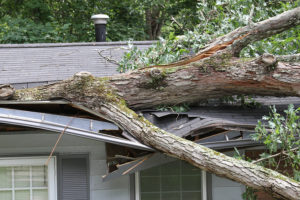 A tree falling on your house is a scary situation. Here in Massachusetts, particularly on Cape Cod and the coast, we’re no stranger to high winds, winter storms and downed trees. In the unfortunate event when a tree falls on your house or garage, you’ll want to make sure you’re first and foremost prepared and able to stay safe – and then know how to take stock and handle the aftermath.
A tree falling on your house is a scary situation. Here in Massachusetts, particularly on Cape Cod and the coast, we’re no stranger to high winds, winter storms and downed trees. In the unfortunate event when a tree falls on your house or garage, you’ll want to make sure you’re first and foremost prepared and able to stay safe – and then know how to take stock and handle the aftermath.
It may go without saying, but the first thing that you need to do if a tree falls and damages your house is to get out of there. You and all other occupants should leave the home as quickly and safely as you can after the incident. Once you have moved your family and pets to safety, you should immediately call emergency services. The fire department will help secure the premises.
Once you’re safe and emergency services have been called, it’s time to think about your homeowners insurance. You should call your agent as soon as possible, because you need them to agree to cover the removal of the downed tree as well as the emergency repair costs. Your homeowners insurance policy should cover you against this damage, however it depends on how the tree actually fell. If the tree was uprooted by powerful winds, it should be covered by the average homeowners policy. However, most policies don’t cover negligence, and if a tree is rotted, in decay and ready to fall, it won’t be covered if it’s eventually knocked over by wind or a storm.
Does the tree’s original location matter? If the fallen tree was on your neighbor’s property you should still be covered by your insurance, not theirs, but you should check your policy to be sure. Similarly, if a tree on your property were to fall and damage your neighbor’s house, you most likely would not be liable for any damages unless negligence on your part contributed to the tree falling.
What does insurance cover? In addition to the cost to remove the downed tree and any emergency repair costs, if the fallen tree has caused property damage, your insurance should also cover the removal of tree debris on your property. If a tree falls and doesn’t damage any structures (house, garage, shed, fence), your insurance isn’t likely to cover the cleanup and removal of debris.
How to protect your home from further damage and/or theft? After getting into contact with your insurance company and making sure you’re covered, you’ll want to secure your home. If you can’t live in the house until repairs are made, make sure to secure your windows and doors, and place all your valuables in a safe location. You’ll also need repairs made to any roof or structural damage that may have occurred so you can prevent any additional damage to the house or your possessions.
Once the area is safe and secured, be sure to take plenty of photographs to document the damage to your property. These pictures will help your insurer as they review and process the claim. As a final note, if your car is damaged from a tree falling you’ll need to go through your car insurance, NOT your homeowners insurance to cover the damages. If you have comprehensive coverage on your auto policy, the damage should be taken care of.
Trees can be extremely dangerous and damaging, but having a plan of action and insurance to protect you can help make situations like these a bit easier. Make sure you’re fully covered in the event of an emergency by talking to an RG advisor today!
STILL HAVE QUESTIONS?
Send them our way and we will do our best to help!

Greg Ormon
ADVISOR | PRIVATE RISK
Greg Ormon is a Private Risk Advisor with RogersGray. Greg recognizes how important it is to put a client’s needs first. His goal is to make the process as easy and understandable as possible. Greg specializes in homeowners, auto, boat & yacht, builders risk, special event, umbrella and many other types of personal insurance.
